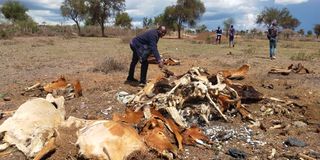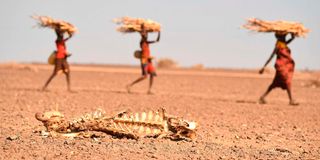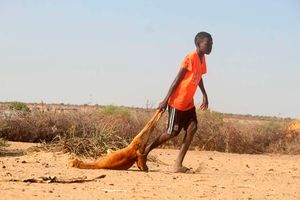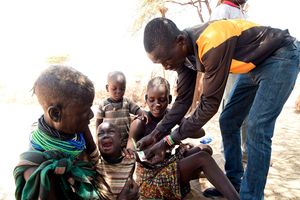What worsened East Africa’s worst drought on record

Simon Kisipan points at a heap of livestock carcases at Ekinye Village in Kajiado East on December 9, 2022.
What you need to know:
- Kenya declared a drought emergency in September 2021, and the situation remained critical in most of its arid and semi-arid regions until the end of 2022. By then, more than 4.35 million people required humanitarian aid.
Human-induced climate change worsened the severity of the 2021-2022 drought in the Horn of Africa, a new study has revealed.
During that period, Eastern Africa experienced one of its worst droughts in the past 40 years, impacting millions of people across countries like Ethiopia, Somalia, and Kenya.
This prolonged dry spell, characterised by significantly below-average rainfall, led to widespread crop failure, massive livestock losses, severe water scarcity, and escalating conflicts.
The drought also left millions of people in dire need of humanitarian aid.
Kenya declared a drought emergency in September 2021, and the situation remained critical in most of its arid and semi-arid regions until the end of 2022. By then, more than 4.35 million people required humanitarian aid.

Women carrying firewood walk past a carcass of a cow in Loiyangalan in Marsabit, northern Kenya, on July 12, 2022.
Nearly one million children aged between six months and five years old and over 130,000 pregnant or nursing mothers suffered from acute malnutrition. The drought also devastated livestock, with over 2.4 million deaths severely impacting pastoral communities, who relied on the animals for livelihood, according to the newly released study published in ScienceDirect.
The study notes that by January 2023, close to 9, 210 metric tonnes of food commodities had been distributed and Sh943 million (USD 7.29 million) cash-based transfers made. In early 2023, the government appropriated a further Sh4 billion to the nation's drought alleviation programme.
And even though most parts of Kenya experienced short rains in march of that same year, the drought conditions did not recover quickly enough to see improvements in food security by mid-2023.
The study further notes that more than 1.7 million people in Ethiopia and Somalia migrated, with at least 60,000 children dropping out of school in Ethiopia. By December 2022, up to 7.1 million people in Somalia were at risk of acute malnutrition and in need of urgent humanitarian aid. More than one million people had moved from their homes, a situation that was exacerbated by concurrent conflicts and disease outbreaks.
“Across the region, drought and high food prices weakened many people's ability to grow crops, keep livestock and buy food. The persistent drought conditions led to substantial harvest failure and poor pasture conditions mainly due to decreased surface water availability. Over the period, there was an increased risk of diseases, malnutrition, and hunger, which fuelled resource-based conflict and migration,” says the study.
“Food insecurity and conflict over scarce resources pushed people to migrate to other places within the region. At least 180,000 refugees from Somalia and South Sudan crossed into the drought-stricken areas of Kenya and Ethiopia,” it adds.
While conducting the study, climate scientists analysed rainfall trends and the combined effect of rainfall deficit with high temperatures in the Southern Horn of Africa covering parts of southern Ethiopia, southern Somalia, and eastern Kenya.
Using climate models and observational data, they assessed changes in 24-month rainfall (2021-2022), as well as seasonal rainfall during the crucial "long rains" (March-April-May) and "short rains" (October-November-December) periods of 2022. The study also considered the region's vulnerability and exposure to such events to understand the full scope of the drought's impact.
The analysis revealed a critical link between human-caused climate change and the severity of the drought. The influence of the environmental change, originating from human activities, combined with the effects of low rainfall and high temperatures, increased evaporation, thus worsening the drought. This combination resulted in major losses of crops and pasture, and critical water shortages.
Human-related activities that have been listed as the drivers of vulnerability and exposure include environmental degradation and land use changes, conflict and fragility, social vulnerability, drought management and response, household coping strategies, and social protection.
“Over the past decades, several factors, including environmental degradation, unsustainable land-use practices and harvesting, overexploitation of grazing land and other pastoral activities, and deforestation, have impacted ecosystems and increased vulnerability of local communities. Several indigenous plants have been declining, including the Yeheb plant, a small tree endemic to the drylands of Ethiopia and Somalia, which contains high nutritional and economic value,” says the study.
The study notes that across Maasailand, pastoral land has been lost, often gradually, with smaller amounts of land being taken by wealthier herders or transferred to outsiders who seek title-deeds as collateral for loans or long-term investments.
“The loss of access to traditional grazing lands and water sources has had devastating effects on pastoralist communities, who rely on mobility and flexibility to manage their herds during times of drought. The large influx of refugees into Kenya over the years has increasingly stretched the few resources available, contributing further to environmental degradation.”
The study notes that in areas like Ethiopia, environmental degradation has manifested through decline of indigenous plants that contained high nutritional and economical value, acquisition of land by international agro-businesses, a large number of foreign investors leasing millions of hectares of land with licences for commercial farms, and development of hydropower plants that have driven land dispossession.
The study notes that conflict and fragility in Somalia worsened environmental and natural resource challenges. Drought and water insecurity, for example, have resulted in increased social competition in arid and semi-arid regions, especially for pasture and water.
“During the 2021-22 drought period, many Somalis lost their livelihoods, which led to soaring food prices, and their coping capacities were stretched too thinly to recover. Others crossed the border to seek help in Kenya and Ethiopia, joining a large existing refugee population,” says the study.
Poverty makes communities both more susceptible to shocks like the 2021-22 drought. It also makes them less able to invest in measures that would reduce their risk. The Horn of Africa region has a large population already struggling with chronic food and water insecurity, malnutrition, and limited access to essential services like infrastructure, healthcare, education, and social safety nets.
Many rural communities across Ethiopia, Kenya and Somalia lack electricity, while those relying on climate-sensitive livelihoods such as rainfed agriculture, agropastoralism, and pastoralism are especially vulnerable to drought and among the hardest hit.
“Evidence suggests that drought is the natural hazard most closely associated with poverty. With the recurrent extreme climate conditions experienced in recent years, households have been forced to spend their limited assets on buffering losses and damages, consequently pushing them into a poverty trap,” says the study.
The study also notes that unequal institutional capacities and drought management response from the three countries may have impacted how well they responded to the droughts, and how well they cushioned their people. Drought response plans are also significantly underfunded, raising questions about their long-term impact on resilience.
“Given the anthropogenically induced drying trend in rainfall, there are implications for both short-term drought management and long-term adaptation. A focus on reduction of vulnerability and exposure, approaches that are robust to both wet and dry extremes and increasing the capacity of people to cope with these types of events is needed to support short-term and long-term adaptation and resilience,” advises the study.
“However, questions remain whether soft or hard adaptation limits have been reached. While more and better designed drought response measures may help decrease poverty and increase resilience to shocks when they occur, certain crops, animals, and by extension livelihoods, may become increasingly difficult to sustain in the changing climate.”





